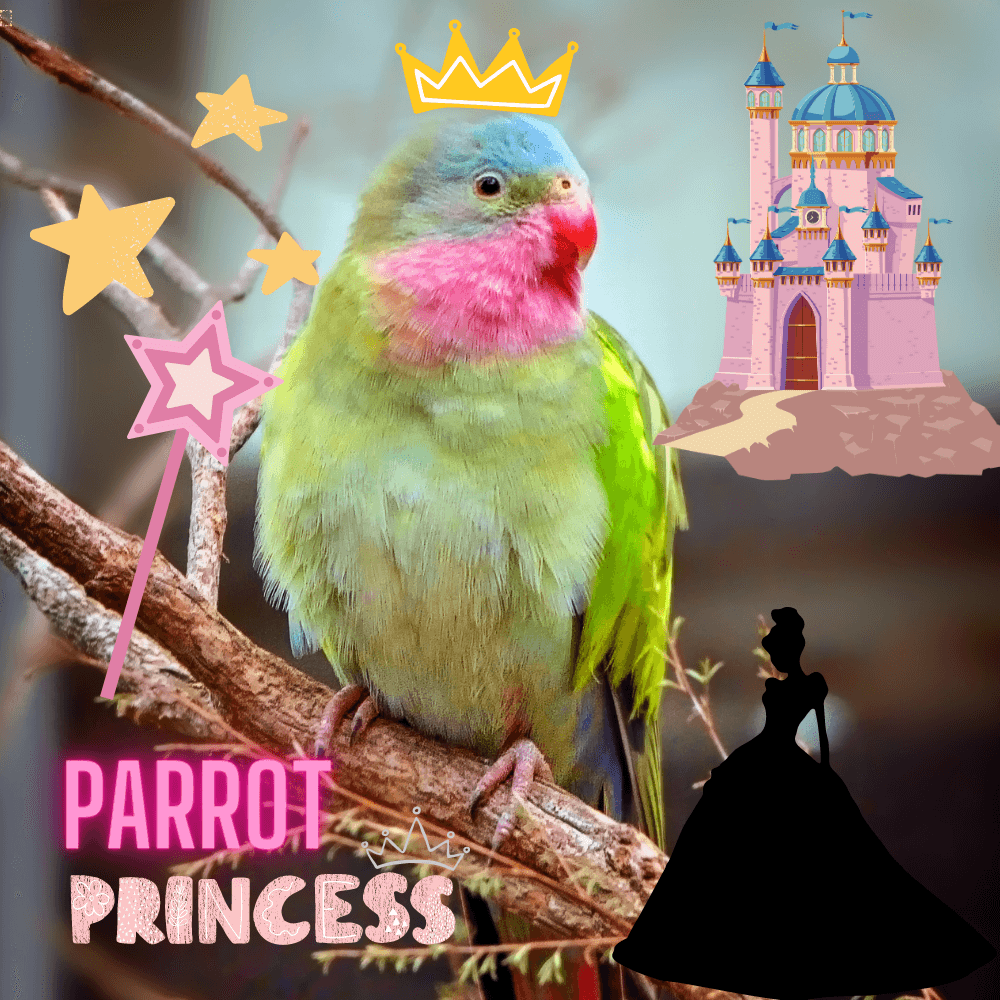
What do princess parrots look like as pets? Why is this parrot a princess? The princess parrot or Polytelis Alexandra is an Australian parrot whose scientific name is Polytelis Alexandra. Indeed, it was named in honor of Princess Alexandra of Denmark (1844-1925). Princess Alexandra married Edward, Prince of Wales, and when he became King Edward VII of Great Britain on 22 January 1901, she became Queen.
This charming bird is known by different names including Alexandra’s parrot, Princess of Wales’ parakeet, Princess Alexandra’s parrot, Queen Alexandra’s parakeet, pink-throated parakeet, and Spinifex parrot. Of course, there are male and female princess parrots, but they are all called princesses!

Princess parrots
Where they live in nature
I have seen them in the wild in the inland desert areas of South Australia, but I believe they are also found in Western Australia, in the desert and mountainous areas. They are nomadic and fly together in groups and can often be found – and heard – near water points and other water sources.
They make gentle but noisy animals
One of the first things you notice about these parrots at a distance is their piercing calls. They make good, gentle pets and even seem to be affectionate, but their appeal when they’re inside and deciding they need attention can be deafening.
Physical description
The princess’s parrot is a medium-sized parrot, which is why it is often referred to as a parakeet. The old spelling of parakeet is paroquet. Other Australian parakeets include the hugely popular Budgerigar.
As princess parrots have been bred in captivity for more than a century, several variations, especially in the coloration of their plumage, have evolved or been bred in them. There are also variations in nature, but they are not as pronounced.
- Length: The male reaches about 46 cm in length; The female is somewhat shorter.
- Weight: These birds are surprisingly light as the largest males weigh only about 120 g (4 ounces and a quarter)!
- Plumage: In nature, the plumage of this bird is usually green with a pink throat, a bluish crown, green shoulders and a pretty blue rump, although there are also blue and yellow mutations. The tail is quite long and thin. It is somewhat shorter in females. It is not as colorful as the male and its crown is pale grey.
- Beak and eyes: As you can see in the top and bottom photos, the male’s beak is coral red and his eyes have an orange iris; The female’s bill is paler and its iris is brown.
- Diet: In nature, they are nomadic and feed mainly on spinifex and other seeds. They fly in herds and suddenly appear in an area, feed there for a while, and then disappear just as suddenly.
How to care for your pet
Parrot princes make wonderful pets. Here are some notes on how to keep these birds as companions:
Housing
Parrot princes adapt well to cage life and freedom of flight in a house. They also appreciate the larger space of an outdoor aviary. Because of their long tails, they need a lot of space when perching.
Feeding
In captivity, they like to eat parrot mixture and love vegetables (such as corn), sprouted seeds, and a variety of fruits (such as apples and pears). During the breeding season, they appreciate certain insect-based treats such as mealworms, which provide additional nutrition for chicks and their parents.
Beak care
As their beaks continue to grow, parrot princes should be provided with small, hard-to-chew branches. Make sure they are not toxic.
Behavior
As pets, they are charming in their behavior and have a real personalities, even showing their likes and dislikes for different family members or visitors.
They can learn to imitate the human voice quite clearly if they are taught to speak from an early age, although this may require patience.
Lifespan
They reach maturity at the age of about a year and live surprisingly long; Some lived between 15 and 30 years.
Breeding
Like most other parrots, in the wild they nest in a hollow tree, preferring eucalyptus and blackbirds. Like many inland birds, in the wild, they breed mostly when it has rained and there is enough food for the chicks. However, they breed well in captivity, especially if they have a hollow trunk, but room must be provided for the long tail. They will return to the same trunk to reproduce again, year after year, and so it must be cleaned of mites and diseases every year after use.
They prefer to breed in groups, as in the wild and lay four to six small white eggs that hatch in about nineteen days.
Princess parrots

Questions and Answers
Question: What do you do to gain the trust of a parrot princess?
Answer: Being gentle with your princess and handling her often would probably help, but they are usually very sociable creatures.
Question: What does the parrot princess like?
Answer: If you mean in the sense of food, I have already answered this question. Otherwise, they like to have company, they like to be talked to, and if you sing or whistle at your parrot princess, you will see that he will answer you, often dancing along his perch. Princess parrot loves freedom, so if he is in a large aviary, he will be happy. If his cage is not large, make sure all doors and windows are closed so he can’t escape, and then give him the freedom to fly around the room. You can train him to come back to sit on your shoulder, where he will likely nibble on your hair.
Question: Are parrot princesses particularly loud or vocal compared to a, say a cockatiel?
Answer: Yes, they are certainly full of joie de vivre, and let everyone know!
Question: Can a parrot princess get along well with a five-year-old?
Answer: It depends on the five-year-old. He or she needs to be calm and gentle and approach the bird slowly, but I imagine some five-year-olds may be good enough at that. It is rather a question of the child who gets along well with the bird.
Question: What is the kingdom, class, order, genus, species, phylum, and family of the princess parrot?
Answer: Family Psittacidae (there are about 326 species in the world; 41 of them are found in Australia); Polytelis Alexandra (the full common name of this parrot is Princess Alexandra’s parrot); it is uncommon in nature; his habit is nomadic; it is an endemic breed, recorded only in Australia. You can find more, with illustrations, in Simpson Day’s ‘Field Guide to the Birds of Australia: the most comprehensive one-volume book of identification’, available on www.penguin.com.au
Question: My 9-week-old princess parrot bites when I handcuff her, how can I stop her?
Answer: What do you mean by “handcuffs”? Is it something you put on him or do you hit him? In either case, it’s not a good idea. We need to treat our pets gently and be kind to them. They are large birds and they need space to fly freely in a safe room every day for exercise.
Question: If they are raised by hand early in life, will they most likely be cuddly?
Answer: Newly hatched chicks can be very delicate, so I would be very careful to handle them too young, but it would be good to start as soon as they are still juvenile.
Question: Is it possible to borrow a companion for my female prisoner of war?
Answer: It sounds like a great idea, but the one I’m talking about belongs to a granddaughter in another state, I’m sorry. I hope you succeed in your quest.
Question: Can parrot princesses fly?
Answer: Yes. They certainly can! They love the freedom of being able to fly in a room, but make sure all windows and doors are closed before trying this one, otherwise you risk losing your pet.
Princess Parrot, The Best Pet Parrot?
SOURCE: Five’s A Flock with Coro




















